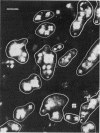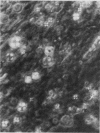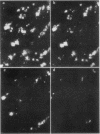Abstract
Frozen sections prepared from human aortic tissue containing fatty streak lesions were examined on a thermally controlled stage with a polarizing light microscope. Distinct birefringent droplets, 0.5-5 mum in diameter, were observed, many apparently aggregated into clusters. The clusters were about 20 X 20 mum in diameter (the approximate size of foam cells). Upon being heated, each smectic droplet exhibited a sudden change of birefringence, indicating a change of state. The transition temperatures were compared to assess compositional distributions in the tissue. We found that for 52% of the clusters the standard deviation of the cluster's droplet melting point distribution was less than half that observed in the surrounding microscopic field. If clusters were intracellular lipid inclusions, this observation indicates that the lipid composition within a foam cell is more homogeneous than that of the overall field. However, using statistical methods, we compared droplet melting populations from cluster to cluster and found significant heterogeneity. The observations can be interpreted to suggest that many foam cells modify the cholesteryl ester fatty acid composition of their accumulations be selective uptake, temporal sampling, or chemical reaction. Furthermore, the intercellular heterogeneity suggests that different cells in the lesion may have different metabolic and transport enzyme affinities or be in different states.
Full text
PDF










Images in this article
Selected References
These references are in PubMed. This may not be the complete list of references from this article.
- Engelman D. M., Hillman G. M. Molecular organization of the cholesteryl ester droplets in the fatty streaks of human aorta. J Clin Invest. 1976 Oct;58(4):997–1007. doi: 10.1172/JCI108554. [DOI] [PMC free article] [PubMed] [Google Scholar]
- Geer J. C. Fine structure of human aortic intimal thickening and fatty streaks. Lab Invest. 1965 Oct;14(10):1764–1783. [PubMed] [Google Scholar]
- Hata Y., Hower J., Insull W., Jr Cholesteryl ester-rich inclusions from human aortic fatty streak and fibrous plaque lesions of atherosclerosis. I. Crystalline properties, size and internal structure. Am J Pathol. 1974 Jun;75(3):423–456. [PMC free article] [PubMed] [Google Scholar]
- Lang P. D., Insull W., Jr Lipid droplets in atherosclerotic fatty streaks of human aorta. J Clin Invest. 1970 Aug;49(8):1479–1488. doi: 10.1172/JCI106365. [DOI] [PMC free article] [PubMed] [Google Scholar]
- PUTT F. A. Flaming red as a dye for the demonstration of lipids. Lab Invest. 1956 Jul-Aug;5(4):377–379. [PubMed] [Google Scholar]
- Smith E. B., Evans P. H., Downham M. D. Lipid in the aortic intima. The correlation of morphological and chemical characteristics. J Atheroscler Res. 1967 Mar-Apr;7(2):171–186. doi: 10.1016/s0368-1319(67)80079-6. [DOI] [PubMed] [Google Scholar]
- Smith E. B., Slater R. S. The microdissection of large atherosclerotic plaques to give morphologically and topographically defined fractions for analysis. 1. The lipids in the isolated fractions. Atherosclerosis. 1972 Jan-Feb;15(1):37–56. doi: 10.1016/0021-9150(72)90036-6. [DOI] [PubMed] [Google Scholar]





